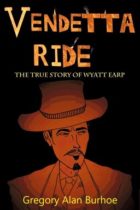Western Author Tom West…
Tom West ACE Double Western Book Reviews: Gallows Gulch & The Man At Rope’s End
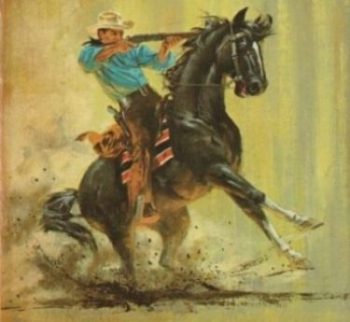
Tom West: Classic Ace Double Western Author Remembered & Reviewed
In his 1960 Western novel THE PHANTOM PISTOLEER, after a ranch house, barns, blacksmith shop and wagon shed are burned flat to the ground, we read: “Wal,” said the foreman wryly, “there’s less cover for the coyotes.” Tom West, folks…
If I were to list my Top 10 Movies of All Time, four of them — Rio Bravo, the original True Grit, The Shootist, and The Good, the Bad and the Ugly — are Westerns. [1]
Why not? I’m a Boomer and we grew up with ’em. Most Saturdays, we eagerly lined up outside the Paramount and Strand Odeon theatres to catch the matinee. “Sure loved them old Westerns!”
Our heroes rode hard and fought hard to bring right and justice to the Old West. Sometimes they sang about it. Sometimes they even kissed the girl.
And our libraries and paperback book racks were filled with classic and new fiction by the best frontier authors.
I had already discovered wilderness writers like Charles G D Roberts, Grey Owl, Jack London, Ernest Thompson Seton and Edgar Rice Burroughs. From there it was a quick jump to Zane Grey and Max Brand.
But the first Western author I’d say was a true hero of mine was Tom West. Still is.
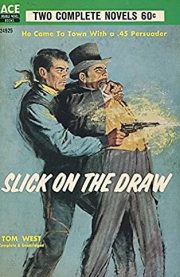 As a kid, I saved my paper route and summer job money and bought those ACE Double Books. You know, those great little paperbacks that have a “Complete Novel” on one side, then — after flipping it over — a “First Book Publication” on the other. [2]
As a kid, I saved my paper route and summer job money and bought those ACE Double Books. You know, those great little paperbacks that have a “Complete Novel” on one side, then — after flipping it over — a “First Book Publication” on the other. [2]
With the ACE Double Westerns, I met tale-tellers like Ray Hogan, Giles A Lutz (aka Reese Sullivan), Gordon D Shirreffs, Louis Trimble, Nelson Nye, Merle Constiner, L P Holmes…
But Tom West quickly became my fave Western Author.
What really caught my attention, besides the fast action and old fashioned romance, was West’s language.
Tom West’s typical hero didn’t just walk through the swinging doors into a saloon to look for the man who had shot his friend, he “pushed through the batwings to lamp and plug the deadly sidewinder who’d beefed his pard.”
And Tom West had something those others rarely showed: humour.
At that time, I was growing up in harness racing country of New Brunswick’s Northern Appalachians. Living with a mixed crew of old horsemen, blacksmiths, farmers, lumberjacks, highways workers. Most of them were war vets. Three things those guys had in common were a willingness to work damned hard, their own language and a real sense of fun and humour.
And that’s where Tom West’s novels seemed so real to me. Later, I would discover the books of Clarence E Mulford of Hopalong Cassidy fame. Another Western Author who had the same reality.
 Who was Tom West? Western writer and keeper of the faith James Reasoner has said that Tom West “was really an Englishman named Fred East.”
Who was Tom West? Western writer and keeper of the faith James Reasoner has said that Tom West “was really an Englishman named Fred East.”
There were brief bios at the beginning of his published works like THE BUZZARD’S NEST and DEAD MAN’S DOUBLE CROSS. They said that London-born East had been severely injured while serving in the British Army on the bloody, barren battlefields of France during the First World War.
“Discharged in his early twenties, he returned home packing a dirty kit bag that contained, among other things, the manuscript of a war novel that he had painstakingly tapped out on an old typewriter during the weary months in the military hospital. The following morning he awoke to find that his mother, to whom cleanliness was next to godliness, had burnt the dirty kit bag and its contents. Thus his first literary effort met a fiery fate.” (While written in the third person, this quote has a distinct “Tom West” feel.)
After that, East moved to the US to further recover his health and find adventure and work. He took a number of hardscrabble jobs, including “choreman, teamster and puncher on ranches in the California west.” Then went back to his literary dreams. He worked for years as a reporter, freelance writer and a book editor.
Some of his writing assignments took him back to Europe. In fact, in later years, friends would remember his love of foreign travel.
And then he set out to be a Western writer.
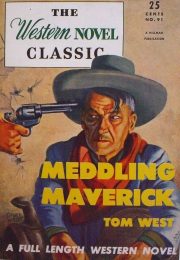 In 1944, at age 59, he published his first full-length novel, going on to write well over sixty more. [3]
In 1944, at age 59, he published his first full-length novel, going on to write well over sixty more. [3]
The Catalog of Copyright Entries for 1944 shows that the novel MEDDLING MAVERICK was written by Fred East (1885-), under the pseudonym Tom West. And published in hardcover by E P Dutton & Co of New York. It was reprinted later that year as a Hillman Publication Western Pulp Magazine Digest (#91 — shown left). An instant “Classic.”
MEDDLING MAVERICK was followed in 1945 by BUSHWHACK BASIN, also from Dutton.
Fred East also published some early works under other names. He saw GAMBLER’S GOLD: A Powder Valley Western published by Jefferson House of New York in 1946 under the house name Peter Field.
And a number of books under his own by-line Roy Manning: TANGLED TRAIL and RENEGADE RANCH from Macrae-Smith Company of Philadelphia in 1948. RED RANGE followed in 1949. Three more “Manning” titles copyrighted by Fred East appeared up to 1958. TANGLED TRAIL, still under the Roy Manning moniker, was reprinted by ACE Books in 1954.
Other titles as by Tom West quickly followed.
RENEGADE RANGE, TROUBLE TRAIL, SPECTRE SPREAD, GHOST GOLD (Pocket Books reprinted the 1949 Dutton hardcover in 1950). FLAMING FEUD, VULTURE VALLEY, GUNSMOKE GOLD (1953, his first original printing with ACE Books). OUTLAW BRAND, KILLER’S CANYON, BATTLE AT RATTLESNAKE PASS, LOST LOOT OF KITTYCAT RANCH, BATTLING BUCKAROOS…
Books I’m reviewing: Tom West’s GALLOWS GULCH was originally published back-to-back with Barry Cord’s THE MASKED GUN (ACE F-250). And his THE MAN AT ROPE’S END was first published with THE HIDDEN RIDER OF DARK MOUNTAIN by Gordon D Shirreffs (ACE F-292) on the flip side. The covers shown below are from the 1970 edition (ACE 27276), when they were finally published together.
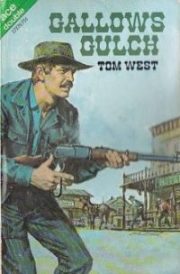 GALLOWS GULCH (1963)
GALLOWS GULCH (1963)
I spoke of Tom West’s “humor.”
There’s nothing to laugh about in this early scene: young Bill Murphy discovers two men “hanging by their necks from the branches of adjoining trees… Nerves taut, scarce breathing, Murphy moved forward on stiff legs, slid out his bowie knife, reached up and severed the taut rope from which the nearer body dangled. His father’s remains fell with a heavy thud. Then he cut his brother down.”
This is a tale of Texas vengeance, with no quarter given.
The humor is in the language of the story, in the names of places and characters. And in the men and women of this scorched, dusty land with their wry outlook on their own lives there.
Deputy Sheriff Baldy Baker, a gaunt, stringy man in faded clothes, a man no more colorful than a weathered old shotgun. Ma Loran, who packed more lard than a hog, was tougher than a basket of snakes and ran the Applejack Saloon. Cuss Curwood, the cattle baron who killed his own skunks (he hated nesters and dealt with them his way). Rio Rucker, the ranch foreman who reminded Bill of a lobo wolf. Paul the Preacher, “a poor disciple wandering the wilderness.” And then there’s Meg Curwood, “pretty as a painted wagon…” but daughter of the man Bill had to kill.
This is a yarn with as many twists and turns as the treacherous trails Bill takes through the bleak, water-starved country. Prime Tom West.
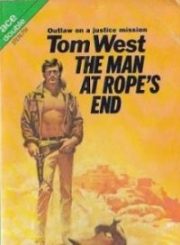 THE MAN AT ROPE’S END (1964)
THE MAN AT ROPE’S END (1964)
Tom West didn’t write often about heroes who were out-and-out outlaws. But Mike Mansfield lived large in Mexico and made a rich enough living rustling cattle north of the Rio Grande.
Until he read about the lynching of his brother George for horse theft in Texas. George was the good brother, straight as a wagon tongue. George was probably carrying a money belt stuffed with dinero from the sale of the family ranch. His brother needed to be avenged.
Mike rode alone into Texas, with no companion except his buckskin horse named Feathers.
Maybe the Law wouldn’t know he was coming? A letter to Sheriff Jake Handley from Señor Mikes’s hot tempered Mexican girlfriend, feeling abandoned, took care of that.
So the cat and mouse game began. Or lobo and jackrabbit game. With the roles constantly changing.
There was an hombre who called himself Red River Rankin, town marshal, a squat, fleshy man with notches on his gun handle. A man Mike quickly recognized as really being Greasy Gleeson, no stranger to backshooting. Mona Carter, with startlingly blue eyes and a gaze as direct as dagger thrusts, who owned the Triangle spread in Comanche Valley.
Pegleg Pagoni, raw-boned, hard-muscled leader of a bunch of nesters in the Hungry Hills — lost his leg to a Triangle bullet. Frosty, a wizened Triangle rider with a white mustache and sardonic eyes, as dehydrated as something spawned by the desert — when he did speak, the young punchers listened.
And a passel of hired gunmen who would turn Comanche Valley into a battlefield of whinnying ponies, cursing men and rolling clouds of dust and gunsmoke…
Well worth collecting, mi amigo.
By the mid-Sixties, the writer known mostly as Tom West had achieved enough success to live out a dream. With their grown son and daughter both living fulfilling lives, Fred and his wife Mildred were able to travel. Spending much of their time “roaming California, Arizona, Utah and other Western states in a trailer.”
And writing more Tom West Western novels.
Not certain when Fred East died — one source tentatively says 1983, two years short of his 100th birthday.
The US Copyright Encyclopedia shows that Mrs Fred East (Mildred F East) was still renewing Fred’s copyrights (on both Tom West and Roy Manning authored works) as late as 1995.
The last new published titles from ACE Books under Tom West’s name were SHOOTOUT AT SENTINEL WELLS (1974) — and PAYOFF AT PIUTE in 1977, when the Great War vet would have been age 92. His last published new works were at the end of the decade: including SAGEBRUSH SHOWDOWN (Zebra Books, 1979) and HARD TRAIL TO SANTA FE (Zebra Books, 1980).
Although the storylines in the last few of his published works were typical Tom, the writing was somewhat flat. Not his rip-roarin’ individualist Old West voice (and laconic hardbitten characters) 0f a man still in his youthful eighty-somethings. It’s possible that these last books were written by others, using the then-popular Tom West name. [4]
Tom West, Western Author, is mostly forgotten now. Humour doesn’t seem to work for modern editors? Maybe. All I know is that Tom — East or West — sure reflected some of the old guys I grew up with. And that makes him a personal “Best.”
“Live Free, Mon Ami!” – Brian Alan Burhoe
[1] “My Top 10 Movies of All Time, four of them are Westerns…”
If you count Northwesterns (aka Northerns) as Westerns, then you can almost double that number. The Wild North (with Wendell Corey as real-life Constable Albert Pedley), Call of the Wild (Charlton Heston version) and Grey Owl (Pierce Brosnan perfectly caught the character of wilderness author Grey Owl). And the original Planet of the Apes is almost a Western, eh? Well, Mamma Mia! and Paul Gross’s Hyena Road are probably Easterns of some kind, but they fill out my Top 10.
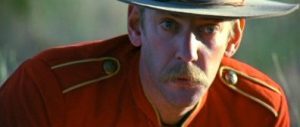
Actually, if I were to add an eleventh, it would either be Dan Candy’s Law (aka Alien Thunder) starring Donald Sutherland as the Mounted Police Sergeant (Sutherland: “Jesus, you’re stubborn. If you was to drown they’d find your body upstream.”) Or Paul Gross’s Passchendaele. Or Kiefer & Donald Sutherland’s Forsaken, a Western. Guess I should just call ’em my Top 13, eh?
Considering that most of my fave TV shows over these many years have been the Sit-Coms, I’m surprised to realise my favourite movies are so serious. Although Rio Bravo does have those scenes where Walter Brennan happily mimics John Wayne’s character. They still break me up.
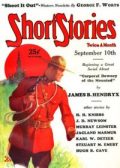 ==>> To read my popular article on the History of Northwestern Fiction, especially the classic tales of our Famous Mounties, go to “The GREATEST WRITERS OF NORTH-WEST MOUNTED POLICE FICTION”
==>> To read my popular article on the History of Northwestern Fiction, especially the classic tales of our Famous Mounties, go to “The GREATEST WRITERS OF NORTH-WEST MOUNTED POLICE FICTION”
“I just discovered your blog recently and need to dig deeper into it. That post on Mountie fiction is great!” Western Writer James Reasoner
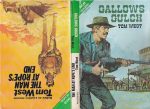 [2] “After flipping it over…” This book style is also known in publishing as Dos-à-dos (back-to-back). It’s a format that goes to early 17th Century Europe, when the NEW TESTAMENT was often printed back-to-back with the PSALTER. So the ACE Doubles were of good origin. Also a great way for a kid to make his hard-earned summer wages go far…
[2] “After flipping it over…” This book style is also known in publishing as Dos-à-dos (back-to-back). It’s a format that goes to early 17th Century Europe, when the NEW TESTAMENT was often printed back-to-back with the PSALTER. So the ACE Doubles were of good origin. Also a great way for a kid to make his hard-earned summer wages go far…
[3] How many books did Tom publish in his almost four-decade career? In how many countries (counting translations)? What American university has a Tom West Collection? To See MY COMPLETE & UNABRIDGED TOM WEST BIBLIOGRAPHY, Go Now To ==>> TOM WEST – The Man Who Wrote His Western Stories In Gunsmoke !
[4] To this point, James Reasoner has written: “I can see Wollheim getting some of his other Western writers to pitch in and write ‘Tom West’ books if there was a problem with Fred East, since the by-line was popular.” jamesreasoner.blogspot.ca/2012/07/forgotten-books-buzzards-nest-tom-west
Wal, I gotta drift…
Live Free – Brian
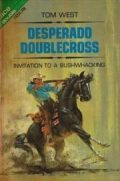 Source: Part of this posting “Tom West – Classic Ace Double Western Writer…” originally appeared as a personal Comment I put on BestWesternBooks.com. If you’re an old Western fan like me, check ’em out. They still live in Wayback Machine’s Archives: bestwesternbooks.com/top-10-western-novels
Source: Part of this posting “Tom West – Classic Ace Double Western Writer…” originally appeared as a personal Comment I put on BestWesternBooks.com. If you’re an old Western fan like me, check ’em out. They still live in Wayback Machine’s Archives: bestwesternbooks.com/top-10-western-novels
Title: Tom West – Classic Ace Double Western Author Remembered & Reviewed
Keywords: ACE Doubles, ACE Double Western, ACE Double Westerns, book review, Brian Alan Burhoe, cowboy, Fred East. Gallows Gulch, Grey Owl, Jack London Tradition, Man at Rope’s End. Mounties, North-West Mounted Police, Tom West, Top 10, Western Author, Western writer, Western book review, Western movies 2023, Western writer Roy Manning, Western writer Tom West, wilderness.








